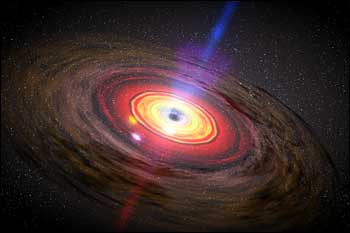Astronomers Describe Violent Universe
The deeper astronomers gaze into the cosmos, the more they find it's a bizarre and violent universe. The research findings from this week's annual meeting of U.S. astronomers range from blue orphaned baby stars to menacing "rogue" black holes that roam our galaxy, devouring any planets unlucky enough to be within their limited reach.
"It's an odd universe we live in," said Vanderbilt University astronomer Kelly Holley-Bockelmann. She presented her theory on rogue black holes at the American Astronomical Society's meeting in Austin, Texas, earlier this week.
It should be noted that she's not worried and you shouldn't be either. The odds of one of these black holes swallowing up Earth or the sun or wreaking other havoc is somewhere around 1 in 10 quadrillion in any given year.
This is the glory of the universe," added J. Craig Wheeler, president of the astronomy association. "What is odd and what is normal is changing."
Just five years ago, astronomers were gazing at a few thousand galaxies where stars formed in a bizarre and violent manner. Now the number is in the millions, thanks to more powerful telescopes and supercomputers to crunch the crucial numbers streaming in from space, said Wheeler, a University of Texas astronomer.
Scientists are finding that not only are they improving their understanding of the basic questions of the universe -- such as how did it all start and where is it all going -- they also keep stumbling upon unexpected, hard-to-explain cosmic quirks and the potential, but comfortably distant, dangers.
Much of what they keep finding plays out like a stellar version of a violent Quentin Tarantino movie. The violence surrounds and approaches Earth, even though our planet is safe and "in a pretty quiet neighborhood," said Wheeler, author of the book "Cosmic Catastrophes."
One example is an approaching gas cloud discussed at the meeting Friday. The cloud has a mass 1 million times that of the sun. It is 47 quadrillion miles away. But it's heading toward our Milky Way galaxy at 150 miles per second. And when it hits, there will be fireworks that form new stars and "really light up the neighborhood," said astronomer Jay Lockman at the National Radio Astronomy Observatory in West Virginia.
But don't worry. It will hit a part of the Milky Way far from Earth and the biggest collision will be 40 million years in the future.
The giant cloud has been known for more than 40 years, but only now have scientists realized how fast it's moving. So fast, Lockman said, that "we can see it sort of plowing up a wave of galactic material in front of it."
When astronomers this week unveiled a giant map of mysterious dark matter in a supercluster of galaxies, they explained that the violence of the cramped-together galaxies is so great that there is now an accepted vocabulary for various types of cosmic brutal behavior.
The gravitational force between the clashing galaxies can cause "slow strangulation," in which crucial gas is gradually removed from the victim galaxy. "Stripping" is a more violent process in which the larger galaxy rips gas from the smaller one. And then there's "harassment," which is a quick fly-by encounter, said astronomer Meghan Gray of the University of Nottingham in the United Kingdom.
Gray's presentation essentially showed the victims of galaxy-on-galaxy violence. She and her colleagues are trying to figure out the how the dirty deeds were done.
In the past few days, scientists have unveiled plenty to ooh and aah over:
* Photos of "blue blobs" that astronomers figure are orphaned baby stars. They're called orphans because they were "born in the middle of nowhere" instead of within gas clouds, said Catholic University of America astronomer Duilia F. de Mello.
* A strange quadruplet of four hugging stars, which may eventually help astronomers understand better how stars form.
* A young star surrounded by dust, that may eventually become a planet. It's nicknamed "the moth," because the interaction of star and dust are shaped like one.
* A spiral galaxy with two pairs of arms spinning in opposite directions, like a double pinwheel. It defies what astronomers believe should happen. It is akin to one of those spinning-armed flamingo lawn ornaments, said astronomer Gene Byrd of the University of Alabama.
* The equivalent of post-menopausal stars giving unlikely birth to new planets. Most planets form soon after a sun, but astronomers found two older stars, one at least 400 million years old, with new planets.
"Intellectually and spiritually, if I can use that word with a lower case 's,' it's awe-inspiring," Wheeler said. "It's a great universe."
more....
The Violent Universe
It s a bizarre and violent universe
The deeper astronomers gaze into the cosmos, the more they find it's a bizarre and violent universe. The research findings from this week's annual meeting of U.S. astronomers range from blue orphaned baby stars to menacing "rogue" black holes that roam our galaxy, devouring any planets unlucky enough to be within their limited reach.






